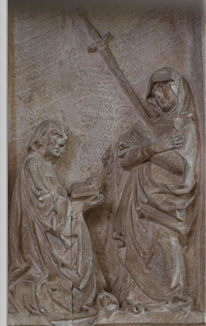|
Subordinate to the general goal to provide a view from below at religious life in late medieval and early modern Transylvania, the project has a number of general aims as well as specific objectives for each year corresponding to the structure of the research.
General Aims
The first aim of the project is to assess the level of integration by the laity of the norms of correct belief and right conduct formulated by the ecclesiastical institutions. By scrutinizing the way official prescriptions were followed or rather observed in very genera terms, the attainment of the first aim of the project would highlight religious practices at the intersection of ecclesiastical prescriptions and lay initiative. The second aim will be to assess the religious practices of the laity, particularly devotional ones. The third aim of the project involves further exploration of lay religious experience from the point of view of its role within the shaping of religious/confessional identities in a multi-religious and multi-confessional region.
Specific Objectives (October-December 2011)
The objectives established for the first year of the project, 2011, that is the identification of primary sources and the relevant bibliography for the selected research topics have been successfully fulfilled.
Specific Objectives (2012)
The principal aim of the second year of the project has been to clarify the theoretical framework for the research topic and discuss the relevant concepts such as popular religion, religious culture and lived religion. This has been achieved by organizing an international workshop at the end of the year (2 November 2012) and through the participation of the research team in a workshop, organized by the director of the project, which benefited from the participation of key figures in the ongoing debate concerning religious culture and the history of devotion, Natalie Zemon Davis, William Christian and Gábor Klaniczay. A second objective of the year has been the enhancement of the team’s resources by acquiring through public competition an additional member specialized in medieval archeology, achieved when the team was joined by Ünige Bencze. Finally, the last major objective of the year, the dissemination of the results of the research undertaken was achieved by publishing the newsletters (in June and December) and through participation in national and international conferences.
Specific Objectives (2013)
The objectives for the third year of the project, the improvement of the research capabilities of the team, familiarity with the secondary literature of the topic and the dissemination of research results have been achieved by applying the concepts chosen and the analytical categories established to the specificities of existing documents, by organizing the workshop Text, Image and Object: itineraries in exploring medieval and early modern religiosity (approach and methods) in November 2013, through visits to archives, churches and libraries in Romania and abroad and by attending national and international conferences.
Specific Objectives (2014)
The fourth year of the project has been dedicated to refining methodology, an objective achieved through individual research and regular meetings where team members presented work in progress. The dissemination of the results of research has been achieved through publication and participation in national and international conferences.
Specific Objectives (2015)
Objective 1 The integration of the results of international research in Romanian scholarship
The team of the project Beyond the Norms: Religious Practice in Medieval and Early Modern Transylvania has decided that in 2015 it would focus as a first objective on the integration of the innovative trends in the study of religious life into Romanian research. Although bereft (for financial reasons) of the direct input implied by actual membership of foreign scholars in the research team, the members of the project have endeavoured to overcome this difficulty by paying increasing attention to the introduction of recent and innovative interpretations, from international scholarship into their research agenda for the year 2015. Adequate solutions for each research topic, individually undertaken by the team members have been included in the methodological discussion which has structured presentations given at national and international conferences, as well as the articles/studies published in the course of 2015 (for details, see the report for 2015). Moreover, the initiation of online discussions with scholars from abroad, which will be made public in the forum section of the project website, has been a novel and, one would hope effective way to foster a lively dialogue with western historiographies.
Objective 2 The confrontation of research results with similar approaches in international scholarly research
The debates that the members of the project’s team have been involved in during 2015 through participation in international conferences and the discussions with historians from abroad with similar research interests concerning the definition of religious life of the laity at the crossroads between church norms and daily devotional practice have focused primarly on the comparison of the analitical and conceptual tendencies formulated on the basis of local source material with similar approaches in western historiography. Serving this comparative perspective, this strategy has benefited from the involvement of the team în research and editorial projects which have broadened the interpretative scope by applying a common set of analytical approaches. Moreover, it is worth noting that the national and international visibility of the members of the research team has had a significant impact on international research in specific fields such as lay religiosity and artistic patronage.
|


